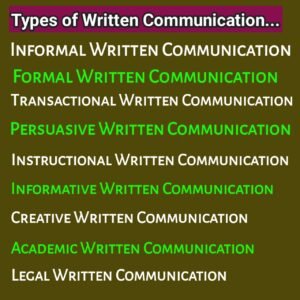Types of Written Communication
Written communication is one of the most important ways of sharing information in both personal and professional contexts. It involves the use of written symbols, letters, and words to convey messages, ideas, or information. There are various types of written communication, each serving a different purpose and audience. Below are detailed explanations of the primary types of written communication.
1. Informal Written Communication:
Informal written communication is typically used in casual or personal settings. It does not follow strict rules or formats and often uses simple language. The purpose of informal communication is to share thoughts, feelings, or information in a relaxed manner.
Examples of informal written communication include:
– Personal letters: Written to friends or family members to share news, feelings, or personal stories.
– Text messages: Short, often informal messages exchanged between individuals.
– Emails for personal purposes: Casual emails sent to friends, acquaintances, or family members.
– Social media posts: Posts shared on platforms like Facebook, Twitter, or Instagram for entertainment or personal expression.
2. Formal Written Communication
Formal written communication is used in professional, academic, or official contexts. It follows specific rules, formats, and structures. The language used in formal communication is polite, clear, and precise.
Examples of formal written communication include:
– Business letters: Used to communicate with clients, partners, or stakeholders for official purposes.
– Official emails: Professional emails sent to colleagues, managers, or clients.
– Reports: Detailed documents presenting information, analysis, and recommendations.
– Proposals: Documents written to suggest a plan, idea, or solution to a problem.
– Memorandums (memos): Brief, formal notes used to communicate within an organization.
3. Transactional Written Communication
Transactional communication is focused on the exchange of information required to complete tasks or transactions. This type of communication is often concise and direct.
Examples of transactional written communication include:
– Invoices: Documents issued to request payment for goods or services.
– Receipts: Proof of payment issued to customers.
– Purchase orders: Requests sent to suppliers for the purchase of goods.
– Contracts: Legal agreements between two or more parties.
4. Persuasive Written Communication
Persuasive written communication aims to influence or convince the reader to take a particular action or adopt a specific viewpoint. This type of communication often uses compelling language, logical arguments, and emotional appeals.
Examples of persuasive written communication include:
– Advertisements: Written content designed to promote products or services.
– Sales letters: Documents sent to potential customers to encourage purchases.
– Opinion articles: Articles expressing a writer’s viewpoint on a specific issue.
– Fundraising letters: Requests for donations or support for a cause.

5. Instructional Written Communication
Instructional communication provides clear, step-by-step information to help the reader complete a task or understand a process. It is typically detailed and easy to follow.
Examples of instructional written communication include:
– User manuals: Guides for using products or services.
– Training materials: Documents used in educational or training sessions.
– Recipes: Instructions for preparing specific dishes.
– Assembly instructions: Step-by-step directions for putting together products.
6. Informative Written Communication
Informative communication is used to convey factual information without expressing opinions or attempting to persuade the reader. The primary goal is to inform or educate.
Examples of informative written communication include:
– News articles: Reports on current events or developments.
– Research papers: Documents presenting findings from academic or scientific studies.
– Data reports: Summaries of collected data and insights.
– Company newsletters: Updates and information shared within an organization.
7. Creative Written Communication
Creative writing focuses on expressing ideas, emotions, or stories in imaginative and artistic ways. It often uses figurative language and literary techniques.
Examples of creative written communication include:
– Fictional stories: Novels, short stories, and other fictional narratives.
– Poetry: Verses expressing emotions, ideas, or observations.
– Screenplays: Scripts for movies, television shows, or plays.
– Song lyrics: Words written for musical compositions.
8. Academic Written Communication
Academic communication is used in educational settings and follows specific formats and guidelines. It often requires thorough research, critical thinking, and proper citation of sources.
Examples of academic written communication include:
– Essays: Structured pieces of writing on specific topics.
– Theses and dissertations: Extensive research papers submitted for advanced academic degrees.
– Research articles: Papers published in academic journals.
– Lecture notes: Summaries of key points from educational lectures.
9. Legal Written Communication
Legal communication involves documents used in legal contexts to record agreements, provide evidence, or convey legal information.
Examples of legal written communication include:
– Legal notices: Formal announcements regarding legal matters.
– Court documents: Records of legal proceedings.
– Affidavits: Written statements made under oath.
– Contracts: Binding agreements between parties.
10. Technical Written Communication
Technical communication provides detailed information about technical or complex subjects. It is often used in fields such as engineering, information technology, and science.
Examples of technical written communication include:
– Technical manuals: Guides for operating complex machinery or systems.
– Software documentation: Instructions for using software applications.
– Engineering reports: Documents detailing technical findings or recommendations.
– Scientific publications: Papers presenting technical research results.
Conclusion
Written communication is a versatile and essential tool for conveying information, ideas, and emotions across different contexts. Understanding the types of written communication and their purposes can help individuals choose the appropriate format and style for their messages. Whether in personal, professional, or creative settings, effective written communication plays a key role in fostering understanding and connection.
See More
Basics of Written Communication

